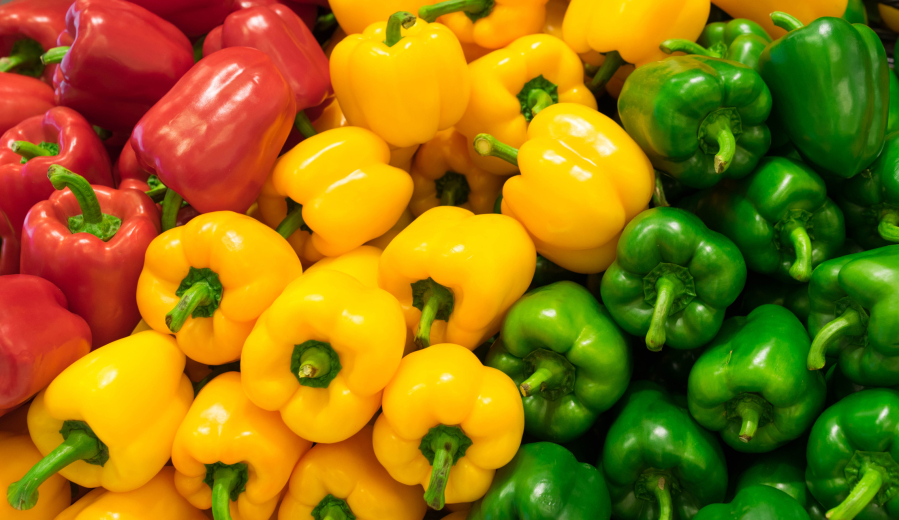Peppers are one of the most versatile vegetables in the market; they run the gamut from mild and sweet to hair-curling hot. With a rainbow of colors to choose from, peppers can brighten any recipe.
Prehistoric remains in Peru show that peppers were valued by that civilization, and they continued to be cultivated in Central and South America for thousands of years. Columbus introduced them to Europe in 1493, where they were quickly adopted and cultivated.
There are hundreds of pepper varieties; all are rated on the Scoville scale, which measures capsaicin, a chemical that binds to nerve endings in the mouth to register pain.
Bell peppers are considered a sweet pepper, with a Scoville index of zero. You will find green bell peppers, yellow bell peppers, red, orange, purple, brown and black. The colors come mostly from their maturity level. Bell peppers can be eaten raw, in salads or with dip on a veggie platter. They hold up well on the grill, in kebabs, or saut?ed in any recipe. The “holy trinity of Cajun cooking” and the base for many Cajun/Creole dishes consist of onions, bell peppers and celery. Bell peppers can be stuffed with meat or vegetarian options, chopped into soups, stews and tomato sauces. They are rich in vitamin A, vitamin C, beta-carotene, and other vitamins and carotenoids, with only 30 calories for one cup.
With a Scoville score below 500, the banana pepper is mild and tangy and perfect for pickling. At 500 to 2,500 units, the versatile Anaheim and Poblano peppers have a mild spicy/sweet flavor that makes them Mexico’s favorite chili peppers. A Poblano that is fully ripened to red and dried is called an ancho pepper.
The familiar jalapeno, (2,500 to 5,000 on the scale) is one of the most versatile hot peppers, found in Spanish, Thai and Mexican dishes. A jalapeno pepper that is dried and smoked is known as a chipotle.
Higher up on the scale at 5,000 to 10,000 units are wax peppers, great for chile rellenos or pickled on a salad or sandwich. At 10,000 to 30,000 units, we find the serrano with a clean, bright flavor and a surprising kick without being scorching hot.
Cayenne peppers are frequently dried and ground into powder. Ground cayenne pepper is a staple on the spice shelf. At 30,000 to 50,000 units, it will bring heat to nearly any dish.
There are many varieties of Thai peppers, but the one thing they have in common is a solid chili kick at 50,000 to 100,000 Scoville units. Approach these peppers with proper respect!
For some time, the Habanero held the record as the hottest pepper in the world, and at 350,000 units it is a seriously hot pepper, popular in sauces, powders and rubs. But a new contender for the title has been cultivated in Wales. The Dragon’s Breath has scored 1.6 million on the Scoville scale.
When purchasing peppers, look for firm, shiny, wrinkle-free skin with no blemishes. Store unwashed bell peppers in a plastic bag in the vegetable drawer for up to a week. Once you cut a bell pepper of any color, it will last only three days refrigerated. They can be chopped and frozen on baking sheets in the freezer. When frozen, store in airtight freezer containers up to eight months to use in cooked recipes. Jalapeno peppers store well in a paper bag in the refrigerator for up to a week. To freeze, slice or chop and place in airtight containers for no longer than one year.
Peppers can be dehydrated, canned or pickled, using tested recipes such as those found at nchfp.uga.edu/how/can_04/peppers.html.
For additional pepper recipes and serving suggestions, check out Chef Scotty’s Market Fresh Recipes at ext100.wsu.edu/clark/?p=8163.
Judi Seifert is a Clark County WSU Extension Master Food Preserver. For additional recipes, food preservation and food safety information visit http://ext100.wsu.edu/clark/?p=1134. Have questions? Call MFP Helpline: 360-397-6060 ext. 5366, or join Facebook Discussion Group “WSU Home Food Preservers – Clark County.”



